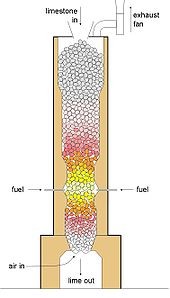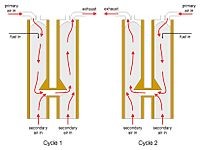Corporate Information
Three modern kilns for producting quicklime
3/22/2012 6:15:32 PM

Cross section of simple shaft kiln
Shaft kilns
The theoretical heat (the standard enthalpy) of reaction required to make high-calcium lime is around 3.15 MJ per kg of lime, so the batch kilns were only around 20% efficient. The key to development in efficiency was the invention of continuous kilns, avoiding the wasteful heat-up and cool-down cycles of the batch kilns. The first were simple shaft kilns, similar in construction to blast furnaces. These are counter-current shaft kilns. Modern variants include regenerative and annular kilns. Output is usually in the range 100-500 tonnes per day.
Counter-current shaft kilns
The fuel is injected part-way up the shaft, producing maximum temperature at this point. The fresh feed fed in at the top is first dried then heated to 800°C, where de-carbonation begins, and proceeds progressively faster as the temperature rises. Below the burner, the hot lime transfers heat to, and is cooled by, the combustion air. A mechanical grate withdraws the lime at the bottom. A fan draws the gases through the kiln, and the level in the kiln is kept constant by adding feed through an airlock. As with batch kilns, only large, graded stone can be used, in order to ensure uniform gas-flows through the charge. The degree of burning can be adjusted by changing the rate of withdrawal of lime. Heat consumption as low as 4 MJ/kg is possible, but 4,5 to 5 MJ/kg is more typical. Due to temperature peak at the burners up to 1200c°in a shaft kiln conditions are ideal to produce medium and hard burned lime.< /p>

Gas flows in two cycles of
operation of regenerative shaft kilns
Regenerative kilns
These typically consist of a pair of shafts, operated alternately. Fitst ,when shaft A is the "primary" and B the "secondary" shaft, the combustion air is added from the top of shaft A, while fuel somewhat below via burner lances. The flame is top-buttom. The hot gases pass downward, cross to shaft B via the so called "channel" and pass upward to exhaust of shaft B. At same time in both shafts cooling air is added from the buttom to cool the lime and to make exhaust of gases via the buttom of the kiln impossible via maintaining always a positive pressure. The combustion air and cooling air leave the kiln jointly via exhaust on top of shaft B, preheating the stone. The direction of flow is reversed periodically (typically 5-10 times per hour) shaft A and B changing the role of "primary" and "secondary" shaft. The kiln has three zones: preheating zone on the top, butning zone in the middle, and cooling zone close to the buttom. The cycling produces a long burning zone of constant, relatively low temperature (around 950°C) that is ideal for the production of high quality soft burned reactive lime. With exhaust gas temperatures as low as 120c° and lime temperature at kiln outlet in 80c° range the heat loss of the regenerative kiln is minimal , fuel consumption is as low as 3,6 MJ/kg. Due to these features the regenerative kilns are today mainstream technology under conditions of substantial fuel costs. Regenerative kilns are built with 150 to 800 t/day output, 300 to 450 being typical.



